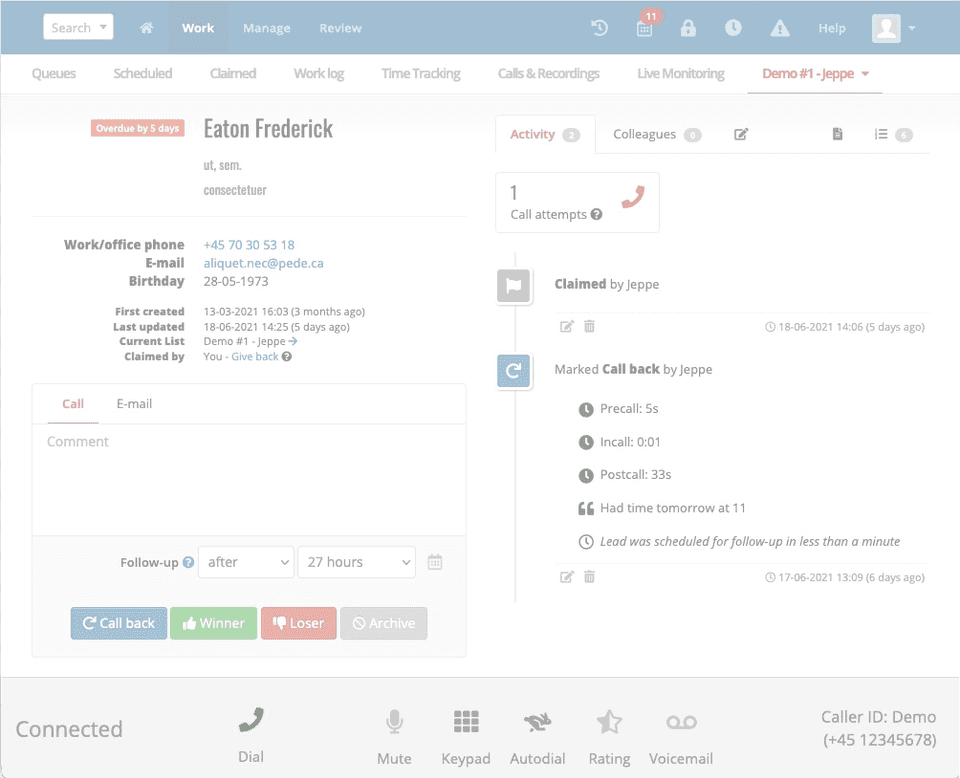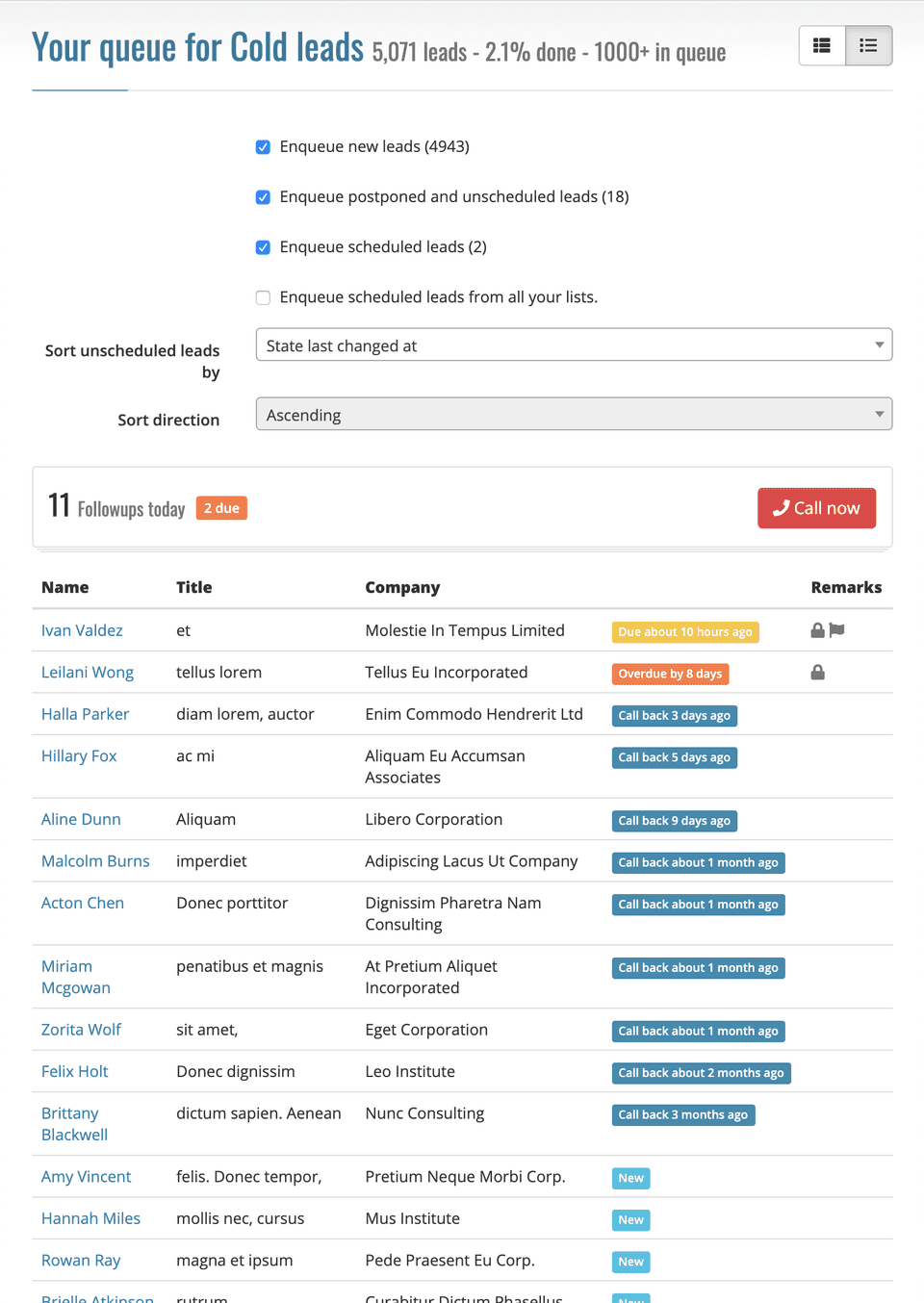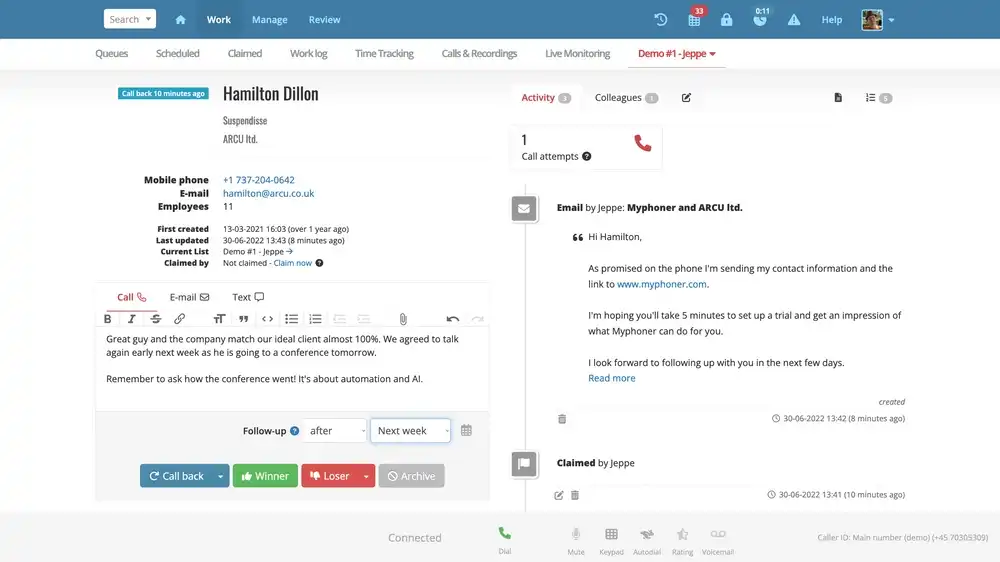Want to Master Your Tone of Voice in Sales Calls? Here’s Our Advice

- January 22, 2024
Quality B2B sales leads are more valuable than ever because of the increasingly challenging nature of current sales lead generation. Traditional cold calling focused on using those leads to simply push a product or service in pursuit of a sale, but today’s B2B selling environment is quite dynamic.
To be successful now, you must first build trust and develop relationships with potential buyers. This means taking the time to understand their needs and pain points to develop corresponding solutions.
A big part of this process is using the right tone of voice in your sales calls. Your voice tonality can make or break a deal, so it’s important to get it right. In this Myphoner guide, we take a look at how you can master your tone of voice to secure the conversions you deserve.
What is voice tonality in sales?
Voice tonality has to do with the modulation and pitch of your voice. It can be used to convey various emotions, such as happiness, sadness, frustration, passion, and more. When it comes to sales, voice tonality has the ability to influence the experience of a conversation and even get a buyer to say yes.
Most people don’t realize the importance of voice tonality and how you can leverage it for your business goals. To be a successful salesperson, it’s beneficial to understand how to use your voice to control the conversation and close more deals.
Why is the tone of voice in a sales call important?
The tone of your voice can make or break a sale. Buyers and sellers subconsciously listen and respond to the tonality and inflection of each other’s voices. The pitch, tone, volume, speed, and rhythm of the spoken language account for 38% of comprehension, compared to 7% for spoken words (the remaining 55% going to visual cues) according to Professor Albert Mehrabian's groundbreaking UCLA study.
Your tone of voice conveys emotion. It's the human aspect we react most strongly to by mirroring the emotions we see in others. So it's not so much what you say, but how you say it that can set the energy in the sales call conversation.
When you reply "no" annoyingly (albeit you had a bad day), the person on the other end can feel the heat and potentially jab back or simply disconnect. When you give lifeless replies to important questions, a potential customer may grow bored and disinterested. It's also difficult to take back something said with a negative tone.
On the other hand, a confident, friendly, and assured tone can radiate positivity to customers and yield better-quality relationships. In order to close more sales, you need to learn how to use your tone to convey emotions and inflections that will help you get the customers on your side.
Why Cold Calling Still Works
To properly use your tone of voice in a sales call, you must first understand why cold calling still works. When you see its potential, you'll understand why it's so important to nail the voice tonality in your sales script. So here are three main reasons why cold calling is worth it:
- Cuts through all the internet noise. Anyone can have a website, blog, or social media page to promote their product or service, and it's becoming increasingly difficult to cut through all the noise. The cold call may appear "outdated" now, but that's also what makes it refreshing to cut out all of that clutter and puts you ear-to-ear with the decision-maker.
- Messaging hits home. With a cold call, you can truly personalize your pitch by adapting to the immediate feedback you're getting. There are no hours between messages, no forgetting and off-putting, a sales call on the phone with potential customers creates a live, personable, and intimate conversation that builds strong rapport way faster.
- Garners trust unlike any other. Today's buyers are savvy, and they know how much fluff and scammy material the internet enables. By conveying a sincere tone of voice over the phone, you remind the listener that there's a human on the other side. You're helping build that trust and then use it to your advantage when closing the deal.
For many online SaaS businesses, cold calling can also help you validate market fit, better understand your client persona, generate meaningful leads, and ultimately grow your business.
For instance, our Monsido case study demonstrates the effective use of cold outreach and highlights the importance of tonality in initial client communication.
Myphoner was a big part of the growth, as it made the SDR’s as efficient as they could be which made them more money, which made them happier. The company would get more meetings and then sell more.
Jacob Riff, Co-founder, Monsido
4 Types of Voice Tonality & When to Use Them in a Sales Phone Call
There are four types of tonality you need to master to use voice tonality for closing deals. Realize that you don't necessarily need to implement just one the entire call. Depending on the context, you can switch back and forth to adapt to the situation.
Relaxed/Playful
The relaxed and playful tonality helps build rapport and encourages conversation. It's perfect for when you're just introducing yourself and making small talk. Use a happy, friendly voice that sounds engaged and inviting. Even though customers can’t see you, they can ‘hear’ a smile in your voice. Speaking as if you are smiling can make your tone sound more positive and friendly.
When you're being relaxed and playful, ask open-ended questions to keep the chat going, and encourage customers to share their thoughts and opinions. This helps you get them to appreciate your service by the end of the call.
Example of a relaxed/playful tone:
"Hey there! Thanks for taking my call. I’m Jill (name) from Peanut Butter Co. (company). How's your day going?"
Focused/Serious
The focused and serious tonality is perfect for negotiations and closed-ended questions. Use a confident, direct voice that projects authority. When you're using a focused and serious tone, emphasize that you're not messing around, get straight to the point, and don't try to be their new best friend. This tonality works especially well in conjunction with an assertive opening statement.
Example of a focused/serious tone:
"We are looking to hit this KPI by March of 2024. All the deadlines are in the file. Here is how we can help you achieve this."
Assertive/Commanding
The assertive and commanding tonality is best for creating a sense of urgency and motivation. It's perfect for making the prospect feel needed and not wasting time with small talk. A strong yet supportive voice that makes them feel like you're their go-to service. When you switch to the assertive and commanding tonality, be concise and to the point. This tonality can also work as a follow-up to the focused and serious tonality.
Confidence, without being overbearing, often instills trust and reassurance in customers. It conveys that you are knowledgeable and capable, which can be comforting to customers.
Example of an assertive/commanding tone:
"I think we can agree that this is a good deal for both of us, so let's move forward and get started."
Friendly/Empathetic
The friendly and non-confrontational tonality is perfect for objections. It's a supportive voice that adopts empathy and understanding, helps the customer feel comfortable to voice their concerns, and encourages them to continue. This can include matching their emotional tone when appropriate and acknowledging their concerns.
Assure customers that there's no judgment or pressure and that ultimately, you're on the same side. By using this voice tonality, you'll be able to understand their concerns and better address them in the future.
Example of a friendly/empathetic tone:
"I totally get where you're coming from. We see it happen occasionally [SalesCompany] too. Can you tell me more about that?"
Pro tips to master the cold call
Opening a Dialogue
If one accepts the idea that the real aim of cold calling is to open dialogue instead of present, the focus quickly shifts to creating connections. An article in Entrepreneur highlights the importance of seeking such connections when it says, "Whether through online research or during the phone call itself, you should try to find a personal connection with your prospects."
Since cold calling can be quite challenging with low success rates, many salespeople abandon the practice in favor of email. The ease with which B2B emails are sent out so easily is seductive–especially when contrasted with the challenges of modern-day cold calling discussed in a National Association of Sales Professionals article. However, emailing is often easy but not as effective.
Cold calling creates a real human connection because both individuals decide to invest time and effort in one another. This often leads to bonds that join the parties in important ways. Long-lasting clients grow sales and build your brand. Not to forget, they often generate the best sales leads of all – referrals!
Tweak Your Tone of Voice
Of course, facial expressions and body language are unavailable during cold calling. Over the phone, conveying empathy, honesty, and enthusiasm is largely accomplished through these verbal tools:
- Inflection: Changing the pitch of your voice can make your words more exciting, energetic, or sincere.
- Emphasis: Underlining certain words can help convey enthusiasm and importance.
- Pace: Speaking too quickly can make you sound nervous or stressed; speaking too slowly can make you sound disinterested or unprofessional. It’s best to find a balance that works for you.
- Modulation: This term refers to the way we use our voice to show feelings like happiness, sadness, frustration, surprise, or fear.
- Mimicry: Though you want to sound energetic and passionate about your product, mimicking the prospect’s tone and pace can smoothen a conversation’s flow and put the individual more at ease. You don’t want to sound overly excited while the caller remains rather calm—or vice versa. It’s not very personal or receptive.
Add inflection to the right words to come across as more passionate and therefore more convincing. Likewise, a high-pitched, emphatic tone suggests enthusiasm, which has shown better recall in listeners and increased motivation to do something. The right pace or cadence offers a digestible listening experience.
Those speaking in a plodding manner come across as tired or disinterested, and rapid-fire deliveries are also problematic because they suggest nervousness or hucksterism. So voice modulation is also important. A voice that rises and falls at the right times shows engagement and interest, while a monotone voice suggests boredom.
You should aim to master inflection, pace, and modulation to convey a positive attitude. Strike the right tone, and the chances increase that your prospects will be intrigued by this empathetic, upbeat person they've encountered. Also, don't underestimate how attractive the prospect of a warm connection might be to someone facing challenges on the job or at home.
The sales professional who masters verbal communication gains a real advantage. The fact that salespeople often struggle with cold calling creates an opening for those who invest time and effort to master the necessary skills. When you can connect with prospects in a way that makes them comfortable, they are more likely to stick around and hear what you have to say. And that's the first step to a fruitful and profitable relationship.
How to Avoid Sounding Too Salesy
It's no secret that many people view cold calls with suspicion, and rightfully so. After all, most of us have been on the receiving end of aggressive, pushy cold calls that seem designed to take advantage of us.
If you want to know how to master phone sales, you must avoid the common missteps that drive prospects away. A good place to start is by examining some of these habits and making adjustments to your approach.
Stop being too pushy
One of the quickest ways to turn off a prospect is to be overly aggressive or pushy. This can be a particular problem for new salespeople.
It's not surprising that many people have a knee-jerk negative reaction to being cold-called. The immediate response for these individuals is to be defensive, and the best way to elicit this reaction is by being too pushy or overly aggressive.
If you're coming on too strong, dial it back. Start by introducing yourself and explaining why you're calling. Let the prospect take the lead and don't rush them.
Don't ramble on
Another common mistake that salespeople make is talking too much. This can be a particular problem if the salesperson is nervous.
In many cases, the prospect senses that he or she is being given a sales pitch and responds by shutting down. If you're talking too much, take a breath. Let the prospect get a word in edgewise and listen attentively to their response.
Don't be self-centered
Many salespeople are mistakenly too self-centered in their conversations with prospects. They may try to build rapport by sharing negative stories about their company or their industry, for example.
While it's important to be genuine and open, it's not the best way to open a cold sales call. Prospects don't want to hear about your problems out of the blue–they have enough of their own. It's always a better idea to start with what's in it for them.
Many salespeople make this mistake. Remember, this is a dialogue, not a monologue. Share a little bit about yourself, but always be sure to focus on the prospect's needs.
Be genuine
Making a genuine connection with the prospect is the best thing you can do to not sound like a salesperson. There’s a real person on the other end of that phone, and you could alienate them from your business by making them feel as though you’re not willing to make a human connection with them.
Listen to them, and sympathize with their issues. Don’t treat them as a ‘job’, but rather as someone you would like to assist. That way, you can sell your service as an answer to their problem — you’ve listened first, and then come to them with a solution.
In a world filled with automated machines and synthetic voices, it’s important to stand out amongst the crowd. Be authentic, and human. Any prospective customer would want to interact more with a real, genuine person, rather than just someone sounding as though they’re bored on the job.
The change of pace will often be refreshing and entice a customer to feel as though they can trust you.
Listening is crucial
Listening to your prospect is crucial to capturing and maintaining their attention. As said before with mimicry, the real-time feedback that you get from a customer is of utmost importance.
A conversation is made between two people, and a lack of active listening can quickly turn a call sour. By listening to your prospect, you can make sure to keep in line with their ‘rhythm’ — their tone of voice, their natural talking rhythm, and their volume, which can help you hit your product home.
For example, it would be better to take a more assertive approach to a customer who needs a fast solution. This makes sure their needs feel met quickly.
Customers who aren't sure what they need would benefit more from a relaxed approach, exploring all the options. In doing this, by listening you can make sure that you’re asking the best questions you can and make sure your lead is highly satisfied with your service without feeling coerced.
Organize your cold calling with Myphoner
“Tidy space, tidy mind” is a saying that is especially important here. A stressed and disorganized caller can make their prospect completely disinterested in their product.
So, instead of leaving your cold calls in a mess, why not organize your cold calling workflow using Myphoner’s Power Dialer?

With our Power Dialer, you can alleviate the stress of having to line up call after call. The robust feature automates your calls from one to the next, making sure your time isn’t eaten up by having to constantly dial each number. This can save hours of your time, especially when going from voicemail to voicemail.

Better yet, you can pair our Power Dialer feature with effective tonality techniques, like using urgency or a caring tone to increase engagement during calls.
Myphoner provides lead tracking and email templates for efficient sales follow-ups. This is valuable because your sales agents can utilize different tonal patterns for various stages of lead tracking while sending follow-up emails.
Our Lead Router goes a step further by helping you organize and share your leads with the rest of your team. You don’t even need to claim your leads manually. The Queue allows multiple agents to work on the same list with automated claiming based on rules controlled by a manager. When managing multiple leads, tonality can help personalize your interactions, making each client feel valued despite the automated processes.
For your organization, you may consider using the following tactics to help your sales team with voice tonality in sales calls while using Myphoner:
- Training sessions: Organize training sessions for sales teams on effective tonality, using real examples from your Myphoner call recordings.
- Role-playing scenarios: Implement role-playing exercises that allow sales teams to practice different tonalities using Myphoner’s interface and features. This way, they can gain confidence in applying the appropriate tone for various client sale cycles while using Myphoner.
Myphoner allows you to work from anywhere! This allows you to be in the most comfortable environment–whether at home, in the office, or even on the beach! Familiar surroundings help reduce stress and improve your tonality and confidence.
Wrapping Up
Tonality in sales calls is a nuanced yet powerful tool that can significantly influence client perceptions and decisions. The next time you tap into your sales leads database, remain aware of the importance of the inflection, pace, and modulation of your communication.
If you choose Myphoner as your cold calling organization solution, understanding and skillfully applying the right tonal patterns can enhance your sales process’s effectiveness, leading to improved client relationships and increased sales.
Myphoner promotes lead nurturing via real connections with real people.
Creating Real Connections with Myphoner


Written by
Jeppe Liisberg
Jeppe Liisberg is a forward-thinking entrepreneur and software developer who has built and contributed to multiple successful startups. With a philosophy centered on creating focused, specialized solutions that excel at solving specific challenges, Jeppe founded Myphoner after identifying a critical gap in the market for effective cold calling software.
"I believe that exceptional software should solve one core problem extraordinarily well rather than attempting to be everything for everyone," says Jeppe. "After years in the trenches as an entrepreneur, I couldn't find a cold calling solution that truly met the needs of small businesses and sales teams—so I built Myphoner to fill that void."
Today, Jeppe remains personally invested in Myphoner's success and customer satisfaction, personally welcoming new users and actively responding to feedback. This hands-on approach ensures that Myphoner continues to evolve based on real user needs while maintaining its commitment to simplicity, effectiveness, and affordability.
Connect with Jeppe on LinkedIn or reach out directly at jeppe@myphoner.com.
Related articles

Industry Related
The Ultimate Guide on Sales and Operations Planning
Learn why sales and operations planning is vital for any sales team & how to effectively implement planning within your organization.
July 28, 2022

Industry Related
A simple way to calculate return on sales
Learn what return on sales (ROS) means, how its beneficial for your sales team & how to effectively calculate your business's ROS.
July 14, 2022

Industry Related
Why Sales Support Matters
Understanding why supporting your sales team is the first step to providing the support to set them up for success.
June 30, 2022